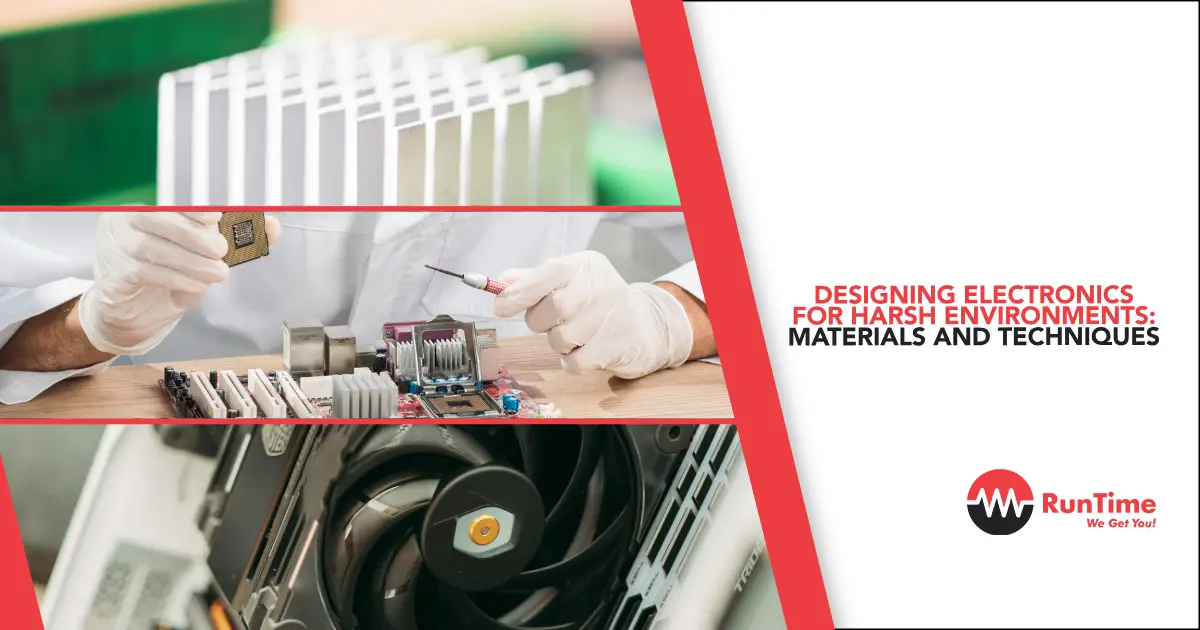Embedded systems are increasingly being deployed in harsh environments, from the scorching heat of industrial furnaces to the freezing cold of Arctic research stations. These environments pose unique challenges for electronic devices, including extreme temperatures, humidity, vibration, and exposure to corrosive substances. Designing electronics that can withstand such conditions requires careful selection of materials, robust design techniques, and rigorous testing.
For embedded engineers, mastering the art of designing electronics for harsh environments is essential for ensuring reliability, longevity, and performance. This article will explore the key challenges, materials, and techniques for designing electronics that thrive in harsh conditions. By the end, you’ll have a comprehensive understanding of how to create ruggedized embedded systems that can operate reliably in even the most demanding environments.
1. Understanding Harsh Environment
Harsh environments are characterized by conditions that can degrade or damage electronic components. These conditions include:
- Extreme Temperatures: High heat can cause thermal stress, while low temperatures can lead to material brittleness.
- Humidity and Moisture: Water ingress can cause short circuits and corrosion.
- Vibration and Shock: Mechanical stress can damage components and solder joints.
- Dust and Particulates: Accumulation of dust can interfere with moving parts and cause overheating.
- Chemical Exposure: Corrosive substances can degrade materials and coatings.
- Radiation: High-energy particles can disrupt electronic circuits, especially in aerospace applications.
2. Key Challenges in Harsh Environment Design
Designing electronics for harsh environments involves addressing several challenges:
- Thermal Management: Ensuring components operate within their specified temperature ranges.
- Moisture Protection: Preventing water ingress and condensation.
- Mechanical Robustness: Withstanding vibration, shock, and physical impact.
- Corrosion Resistance: Protecting against chemical exposure.
- Reliability: Ensuring long-term performance under extreme conditions.
3. Material Selection for Harsh Environment
The choice of materials is critical for designing electronics that can withstand harsh conditions. Here are some key considerations:
A. PCB Materials
The PCB substrate must be able to withstand thermal, mechanical, and chemical stresses.
- FR-4: Standard PCB material, suitable for moderate conditions.
- High-Tg FR-4: Offers better thermal stability for high-temperature environments.
- Polyimide: Excellent thermal and mechanical properties, ideal for aerospace and military applications.
- Ceramic PCBs: Provide superior thermal conductivity and resistance to extreme temperatures.
B. Conformal Coatings
Conformal coatings protect PCBs from moisture, dust, and chemicals.
- Acrylic: Easy to apply and remove, suitable for moderate protection.
- Silicone: Offers excellent thermal and moisture resistance, ideal for high-temperature environments.
- Polyurethane: Provides robust protection against chemicals and abrasion.
- Parylene: A vapor-deposited coating that offers superior protection with minimal added weight.
C. Enclosure Materials
The enclosure must protect the electronics from physical and environmental damage.
- Aluminum: Lightweight and corrosion-resistant, with good thermal conductivity.
- Stainless Steel: Highly durable and resistant to corrosion and impact.
- Polycarbonate: Offers excellent impact resistance and transparency for displays.
- Fiberglass Reinforced Plastic (FRP): Combines strength and corrosion resistance.
D. Connectors and Cables
Connectors and cables must be robust and reliable in harsh conditions.
- Sealed Connectors: Prevent moisture and dust ingress.
- High-Temperature Cables: Use materials like PTFE or silicone for insulation.
- Corrosion-Resistant Contacts: Use gold or nickel plating for connectors.
4. Design Techniques for Harsh Environments
In addition to material selection, specific design techniques can enhance the durability and reliability of electronics in harsh environments.
A. Thermal Management
Effective thermal management is crucial for preventing overheating and ensuring reliable operation.
- Heat Sinks and Thermal Vias: Dissipate heat from high-power components.
- Thermal Interface Materials (TIMs): Improve heat transfer between components and heat sinks.
- Active Cooling: Use fans or liquid cooling systems for high-heat applications.
- Thermal Insulation: Protect components from extreme external temperatures.
B. Moisture and Dust Protection
Preventing moisture and dust ingress is essential for long-term reliability.
- IP Ratings: Choose enclosures with appropriate IP (Ingress Protection) ratings for water and dust resistance.
- Gaskets and Seals: Use rubber or silicone gaskets to seal enclosures.
- Desiccants: Include desiccant packs to absorb moisture inside enclosures.
- Venting: Use breathable membranes to equalize pressure while preventing dust and water ingress.
C. Mechanical Robustness
Designing for mechanical robustness ensures that electronics can withstand vibration, shock, and impact.
- Shock Mounts: Isolate sensitive components from mechanical shocks.
- Strain Relief: Secure cables and connectors to prevent damage from pulling or bending.
- Reinforced Enclosures: Use thicker materials or ribbing to strengthen enclosures.
- Component Mounting: Use adhesives or potting compounds to secure components.
D. Corrosion Resistance
Protecting electronics from corrosive substances is critical in harsh environments.
- Corrosion-Resistant Coatings: Apply coatings like zinc or nickel to metal parts.
- Sealed Enclosures: Prevent exposure to corrosive gases or liquids.
- Material Selection: Use inherently corrosion-resistant materials like stainless steel or plastics.
E. Radiation Hardening
For aerospace or nuclear applications, radiation hardening is necessary to protect electronics from high-energy particles.
- Radiation-Hardened Components: Use components specifically designed for radiation environments.
- Shielding: Use materials like lead or tungsten to shield sensitive components.
- Error Detection and Correction: Implement ECC (Error-Correcting Code) memory to detect and correct radiation-induced errors.
5. Testing and Validation
Rigorous testing is essential to ensure that electronics can withstand harsh environments.
A. Environmental Testing
- Temperature Cycling: Expose the device to alternating high and low temperatures.
- Humidity Testing: Test the device in high-humidity conditions.
- Vibration and Shock Testing: Simulate mechanical stresses to validate robustness.
B. Accelerated Life Testing
- HALT (Highly Accelerated Life Testing): Subject the device to extreme conditions to identify failure points.
- HAST (Highly Accelerated Stress Testing): Test for moisture resistance under high temperature and humidity.
C. Field Testing
- Real-World Deployment: Test the device in the actual environment where it will be used.
- Long-Term Monitoring: Monitor performance over time to identify potential issues.
6. Case Studies: Electronics in Harsh Environments
A. Automotive Electronics
Automotive electronics must withstand extreme temperatures, vibration, and exposure to chemicals. Techniques like conformal coatings, sealed enclosures, and robust connectors are commonly used.
B. Industrial Automation
Industrial equipment operates in environments with high temperatures, dust, and moisture. Ruggedized enclosures, thermal management, and corrosion-resistant materials are essential.
C. Aerospace and Defense
Aerospace electronics face extreme temperatures, radiation, and mechanical stress. Radiation-hardened components, thermal insulation, and vibration-resistant designs are critical.
7. Best Practices for Harsh Environment Design
To summarize, here are the best practices for designing electronics for harsh environments:
- Understand the Environment: Identify the specific challenges of the deployment environment.
- Choose the Right Materials: Select materials that can withstand the environmental conditions.
- Implement Robust Design Techniques: Use thermal management, sealing, and mechanical reinforcement.
- Test Rigorously: Validate the design through environmental and accelerated life testing.
- Plan for Maintenance: Design for easy maintenance and replacement of components.
8. Tools and Resources for Harsh Environment Design
Several tools and resources can help embedded engineers design electronics for harsh environments:
A. Simulation Tools
- ANSYS: For thermal, structural, and fluid dynamics simulation.
- COMSOL Multiphysics: For multiphysics simulation, including thermal and mechanical analysis.
B. Testing Equipment
- Environmental Chambers: For temperature and humidity testing.
- Vibration and Shock Testers: For mechanical stress testing.
C. Industry Standards
- IPC Standards: Provide guidelines for PCB design and manufacturing.
- MIL-STD-810: A military standard for environmental testing.
9. Future Trends in Harsh Environment Design
As technology advances, new trends are shaping the future of harsh environment design:
- Advanced Materials: Development of new materials with superior thermal, mechanical, and chemical properties.
- Miniaturization: Designing smaller, more robust devices for compact applications.
- IoT in Harsh Environments: Enabling IoT devices to operate reliably in extreme conditions.
- AI-Driven Design: Using machine learning to optimize designs for harsh environments.
10. Conclusion
Designing electronics for harsh environments is a challenging but essential task for embedded engineers. By understanding the unique challenges, selecting the right materials, and implementing robust design techniques, you can create devices that operate reliably in even the most demanding conditions.
Whether you’re working on automotive systems, industrial equipment, or aerospace applications, mastering the art of harsh environment design will enable you to deliver innovative solutions that stand the test of time. As technology continues to evolve, staying ahead of the curve will require continuous learning and adaptation. Happy designing!









